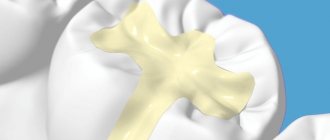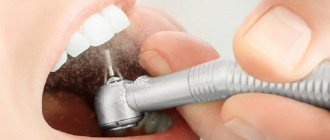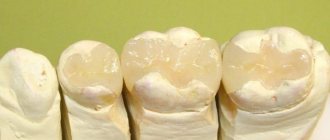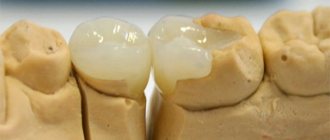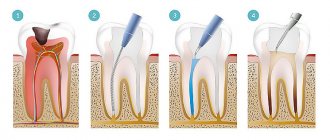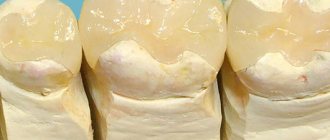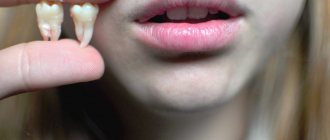Black streaks on teeth, which can cause them to appear
When tooth enamel (although the reason is not necessarily localized in the enamel) changes its color, this is not only a significant problem, but often also a warning about health problems in other organs and systems. Changes in the color of teeth can occur for a variety of reasons - diseases of other organs and systems, diseases of the teeth themselves, and even taking a number of pharmacological drugs can contribute to the occurrence of this cosmetic defect. Moreover, in some cases, the appearance of dark plaque with further development can cause significant damage to the teeth, while in others, black spots or plaque are purely a cosmetic defect.
Causes
The reasons for the appearance of black plaque on teeth can be very different:
- The most common option is plaque from frequent smoking and drinking coffee. Dyes very quickly penetrate the plaque accumulated at the base of the tooth, and over time this sticky mass darkens, hardens and literally grows to the enamel, forming tartar. Nicotine resins, as well as tea and coffee pigments, cause black plaque to form on teeth quickly, but is difficult to remove.
- Often, the formation of black plaque is a complication of serious illnesses, as well as a consequence of long-term use of antibiotics. For example, problems with the spleen, weak liver, various abscesses and complicated viral infections often cause dark plaque on the teeth from the inside.
- Often, blackening of the teeth near the gums occurs among workers of metallurgical enterprises, as well as factories with metalworking shops, shops for assembling finished metal products, etc. The fact is that at such enterprises, condensate containing microparticles of heavy metals, when inhaled, constantly settles on the internal organs, sometimes causing poisoning, not to mention simply staining the plaque.
- The reason for the formation of black plaque in children most often lies in elementary dysbiosis, since in young children the formation of normal intestinal microflora ends only by the age of three. So don’t give in to panic and start actively cleaning such plaque from your children’s teeth. Over time, it will most likely disappear on its own. Well, or, at least, it will go away on its own along with the baby teeth.
- The issue of apple consumption remains controversial. Eating one, maximum two apples a day is good not only for enamel, but also for the whole body. However, during the off-season, store-bought fruits that do not spoil for several months are clearly treated with chemicals that are harmful to health. And it’s unlikely that anyone will eat sour apples in large quantities. Consequently, those who like to go on apple diets eat a huge amount of formaldehyde and other chemical preservatives, as well as sugar, albeit in the form of fructose, every day. So such connoisseurs of a “healthy” lifestyle may also not be surprised at what black plaque means on their teeth.
- Well, the worst reason for the appearance of dark plaque is, of course, drug addiction. Although, in this case, it makes sense to talk not so much about plaque, but about the methodical destruction of all internal organs, including teeth. So there is no longer any talk about restoring a healthy smile.
The effect of pharmacological drugs on tooth color
Tetracycline is a fairly widely used antibiotic. The reasons for this popularity lie in the wide spectrum of action of the drug, a relatively small number of side effects, and also, importantly, its low cost.
But after some time after the start of mass use of the product in different age groups, it turned out that the drug affects bone tissue and tooth enamel. At the same time, the effect of tetracycline is most pronounced on tissues that are still developing, which means the drug exhibits this side effect most pronouncedly when used to treat pregnant women and children.
The effects of tetracycline manifest themselves in different ways; these can be spots, streaks, or a solid staining of the tooth in a grayish or dirty yellow color. Such staining does not pose a threat to the integrity of the tooth, as in the case of caries, and which areas of the tooth will be affected depends on the time of application of the antibiotic - which area is in the process of formation will be stained.
A similar situation can occur when taking iron supplements, but the duration of treatment with such drugs should be quite long. In children, spots after taking iron supplements may disappear on their own within a month.
Methods for restoring the color of teeth after using drugs that affect them
Depending on the volume and degree of damage, different techniques are used to return the white color. Treatment of teeth damaged by antibiotics or other drugs is a step-by-step process: First, the dentist performs a professional cleaning. During this procedure, both soft and hard deposits are removed, which contributes to a more accurate diagnosis and increases the effectiveness of further procedures.
This is followed by sanitation of the oral cavity, which includes treatment of identified diseases of the teeth and gums. Since the main cause of such spots is a lack of minerals in the enamel, the next stage is remineralization. The key chemical elements in this process are calcium, fluorine and phosphorus.
After all previous procedures, experts recommend coating the teeth with fluoride varnish. This substance not only protects the tooth from loss of minerals, but also protects it from the effects of various damaging factors.
Various whitening techniques are also used. A number of methods have been developed to restore the color of tooth enamel; a specialist can choose the method that is most suitable in each specific case.
Features of treatment of the disease
An experienced dentist can treat root caries at the first stage without drilling. In this case, the doctor performs professional cleaning, removes plaque and stones. Then the enamel is remineralized (restored) with a special agent - a gel based on calcium and fluoride. After several remineralization sessions, complete regeneration of the outer shell of the tooth occurs.
At more severe stages of the disease, treatment is carried out using the same methods as for other types of dental caries. However, the procedure can be complicated by the fact that caries is located near the gums.
The process of surgical dental intervention includes several stages.
- Anesthesia. The defect is located too close to the gum and during drilling any movement of the dentist can cause severe pain to the patient, so before the procedure the gum is frozen using a special means.
- Cleaning the tooth from plaque and tartar. During the procedure, the dentist determines the color of the future filling.
- At the next stage, the doctor carefully pushes back the gum if it is affected by caries.
- Then the dentist begins to fill out the carious cavity and removes all dead tissue.
- Next, the cavity is treated with an adhesive - a special substance that promotes adhesion of different materials (tooth surface and filling).
- In the next step, the dentist fills the cavity with a filling. It is applied in layers and each layer is exposed to a photopolymerization lamp. The doctor then grinds and polishes the filling, giving the tooth its natural anatomical shape.
In the future, teeth need constant care. A carious process in the cervical area can occur even next to an installed filling. In addition, if care is improper, there is a risk of secondary caries.
Occupational and endemic fluorosis
Although the chemical element fluoride is extremely important for dental health, its excess in the environment can lead to negative consequences for tooth enamel. Fluorosis develops both as a result of an excess of this chemical element in water and in some industries.
This disease manifests itself primarily as spots or streaks on the teeth; the color of such spots and streaks can vary significantly among different patients. Up to a moderate degree, fluorosis does not damage the tooth enamel, but is only a cosmetic defect (however, at a moderate degree, fluorosis can contribute to the development of caries).
In most cases, making a diagnosis is not particularly difficult, but some forms of fluorosis have significant similarities with caries at the spot stage, which must be taken into account in the differential diagnosis.
For treatment, as in the case of the consequences of the use of antibiotics, there are various methods for treating fluorosis. For mild lesions, cleaning followed by remineralization and bleaching is most often used.
In more severe cases, it is necessary to restore the tooth with filling material.
The main causes of darkening of teeth in childhood
In childhood, various injuries are common. It happens that a child’s tooth darkens after a blow. This can easily damage the vascular bundles that are located inside the pulp. If a hematoma occurs, the tooth begins to acquire an unnatural dark shade due to the penetration of hemoglobin and other pigments into the dental tissue.
In young children, the use of certain medications (for example, antibacterial drugs from the tetracycline category) can provoke the accumulation of the drug in the enamel tissues. This leads to the fact that even the child’s very first tooth appears black.
Why else can a child’s tooth darken?
Fluorosis is a pathology that occurs due to excess fluoride intake. It is usually associated with a high concentration of this element in water, or with excessive use of medications with this component or an incorrectly selected cleaning paste. With this disease, black dots form on children's teeth, which can merge into large dark spots among themselves. In parallel, symptoms of damage to the skeletal and muscular system occur.
Spots and stripes on teeth due to caries
Certain stages of the development of such a common disease as caries are also manifested by the appearance of spots or dark-colored stripes on the teeth, however, in the case of caries, such manifestations as pain after eating too hot, too cold food or sweets are added, although at the stain stage such manifestations are quite rare . More advanced forms of the disease manifest themselves primarily as pronounced tissue defects and pain.
Diagnosis of an advanced process is not difficult - to make a diagnosis, it is enough to insert a dental probe into the carious cavity. The initial forms can be more difficult to diagnose. To confirm the diagnosis in such situations, additional diagnostic tools are used.
The following may be informative in the early stages:
- X-ray examination of teeth.
- Methylene blue is also used - this substance, when applied to a tooth, stains only the affected areas, while healthy tissue and fluorescent spots remain unchanged.
- Sometimes the technique of transluminescence is used - shining through a suspicious tooth with a powerful light source.
Treatment of the disease varies depending on the stage of the process. At the spot stage, in many cases it is possible to limit oneself to remineralization, as well as normalization of diet and oral hygiene. However, if the process is accompanied by deeper tissue damage, then the only way out is the complete removal of non-viable tissue and subsequent filling of the resulting cavity.
Modern polymer materials for filling make it possible to restore not only the function of the damaged tooth, but also its appearance.
For more information about why black stripes or dark-colored spots may appear on teeth and how to get rid of them, watch the video:
What can cause darkening
Slight discoloration can be caused by smoker's stains or dye buildup in the enamel. But in other cases, if the tooth has darkened significantly under the filling, there may be internal problems.
The most basic reasons that will cause blackening:
- consequences of injury;
- pulp death;
- translucency of metal pins;
- dyeing after using tin or silver;
- caries, including secondary;
- inadequately selected treatment;
- internal problems of the body.
Caries is one of the main causes of tooth darkening
One of the most common factors that causes blackening is caries, including secondary ones. It can occur inside a tooth, under a filling, and remain invisible for a long time.
Many patients in dental clinics are faced with situations where, some time after treatment, their teeth under the filling still turn black. This can be caused by the use of materials containing silver or tin; they always cause darkening, but this is only a cosmetic defect.
But if the tooth turns black after removing the nerve and filling it, or it is affected by caries, regardless of the previously provided treatment, you need to urgently seek help from a doctor. Darkening can be caused by stains from cigarette smoke or coffee, tea, as well as constant consumption of drinks with dyes.
If these factors do not answer the question of why the tooth darkened under the filling, then it is necessary to look for internal problems in the body. Even genetic diseases can provoke this.
Also, blackening of a tooth under a filling, or a healthy one, can be caused by problems with the gastrointestinal tract, kidneys and calcium absorption, fungal diseases (candidiasis), abnormal metabolism, impaired acid-base balance, blood diseases and chronic staphylococcal infection.
If any of these diseases are present, you must first begin treating it , and then make your teeth snow-white. Darkening can also be affected by high levels of iron and fluorine in the water. And don’t forget that oral hygiene promotes a more natural color.
The right central incisor is darker than the left after treatment about 15 years ago
Many patients are faced with a situation where the dead tooth is darkened and hurts. There are no vessels, nerves or soft tissues in this one. In fact, it is a dead object that is connected to a living organism only mechanically.
It is held firmly by the gums, the enamel is still quite strong. If depulpation is carried out correctly, it will not break off or crumble for a long time . A dead tooth no longer responds to various stimuli due to the absence of a nerve.
It can only hurt for some time after the procedure for removing nerve endings, or in the case of an incorrectly performed procedure, when part of the nerve endings remain. Problems with a nearby tooth or gum may cause discomfort.
The dead tooth still performs almost all of its main functions. But it does not receive the necessary micronutrients . Dental tissues do not need constant access to nutrients, but without them, over time they begin to lose their normal structure and crumble. Caries appears on them, since a person does not feel pain, the cavity of the caries can increase to impressive sizes, and they need special care.
If you notice darkening of the tooth after nerve removal, what should you do in this case? Even with proper treatment, the pulp cannot be restored, there is no nutrition - this is what causes the darkening of the enamel. And if you end up with an unscrupulous doctor and he provides poor-quality treatment, then organic matter may remain in the canals, and the products of its decomposition will be the cause of blackening of the enamel.
Preventive measures
Oral hygiene reduces the risk of developing most oral diseases. Regular brushing of teeth with toothpaste or powder in combination with dental floss (toothbrushes do not clean the spaces between teeth very well) as well as rinses significantly reduce the risk of developing not only caries, but also many other diseases of the teeth and oral cavity.
In the case of caries, diet plays an important role, since tooth tissue is destroyed by acid, which in turn is formed by bacteria from sugars. Reducing the consumption of sweets significantly reduces the risk of developing caries. A sufficient intake of fluoride into the body is also important.
Fluorosis, especially endemic fluorosis, is difficult to prevent sufficiently, since in most cases it is almost impossible to provide the entire population with water with a normal fluoride content. It is more rational to provide good water only to children, as the most vulnerable part of the population to this disease. It is also believed that in childhood, taking vitamins, especially C and D, reduces the risk of development.
Prevention of the occurrence of tetracycline teeth is also quite simple - tetracycline drugs are simply not prescribed to pregnant women and children, and tetracycline does not pose a serious threat to already formed teeth.
The appearance of dark spots or streaks on teeth can be a manifestation of many diseases, the treatment of which can only be done by a specialist using appropriate technologies and materials. It should be remembered that many dental diseases that manifest themselves in this way can lead to serious consequences, including tooth loss.
What is cervical caries?
Cervical caries is a carious process that is localized at the very base of the tooth and affects its neck and adjacent tissues. This disease is considered one of the most severe in dentistry. Its danger lies in the fact that cariogenic microorganisms quickly penetrate into the deepest tissues and provoke root damage.
Cervical caries must be treated immediately! Timely therapy will help prevent tooth loss and the development of serious diseases such as pulpitis, gingivitis, and periodontitis.
There are several reasons for damage to the neck of a tooth. The disease, as a rule, is provoked by the same factors as other types of caries. However, there are also some peculiarities. Let's consider the main causes of cervical caries.
- Poor oral care. Gingival caries occurs as a result of improper brushing of teeth. This is due to the fact that the root zone is difficult to reach with a toothbrush.
- Anatomical features of the enamel near the gums. At the root areas of the teeth, the enamel is very thin, so it is highly susceptible to the harmful effects of cariogenic organisms.
- A genetic predisposition to gum dehiscence causes the formation of “gum pockets,” where food debris accumulates over time. As a result, cavities appear and caries develops under the gum.
- Violation of the secretion of the salivary glands. Saliva in the human body performs a protective function. A decrease in the amount of saliva produced leads to a decrease in the level of protection of teeth from the harmful effects of bacteria living in the oral cavity. There are the following causes of impaired salivation: regular use of medications, chemotherapy and some diseases of the gastrointestinal tract.
- Radical caries may indicate endocrine dysfunction (the development of diabetes mellitus or disruption of the thyroid gland). After diagnosing the disease, the dentist is obliged to refer the patient for examination to an endocrinologist.
One of the features of the disease is that the defects are often localized in the “smile zone.” Patients with cervical caries experience no fewer psychological and aesthetic problems than people who have had part of a tooth chipped off. That is why cervical caries of the anterior teeth must be treated immediately.
Black streaks on teeth
Hello, I am a nursing mother and have been for a year now. I constantly take special vitamins and follow a diet. I hardly eat sweets. When I recently had a toothache, I looked at it in the mirror and discovered black stripes on my teeth. On the one that was sick and on several others nearby. When I went to the dentist, he found caries, not on the tooth that hurt, but on the bottom one. He said that this is how the nerves react. And about the dark stripes, he said that these are not caries, but they just need to be cleaned better. But the stripes are getting larger and dots have been added to them. I went to another clinic and they said it was pigmentation and I needed to undergo expensive cosmetic procedures. But my teeth hurt, but they say it’s not caries. Help me to understand!
Hello, Natalia. It’s bad that from your message I couldn’t understand where exactly, in what part of the tooth, these stripes appeared. But I'll try to answer. To do this, we will consider all possible options.
If the black stripes on the teeth are located closer to the gums, then this is, in fact, pigmentation. But it occurs not only and not so much because teeth are poorly brushed. Sometimes it's the other way around. If antiseptic pastes and/or rinses are used too actively, such problems may arise. Also, dark stripes occur due to problems with the microflora of the oral cavity, which, in turn, can be caused by intestinal dysbiosis. Such black stripes do not require treatment. You just need to do hygienic teeth cleaning, for example “air flow”. Trying to clean your teeth on your own is not recommended - you can damage your gums.
When black streaks are on the top of the tooth, but the tooth itself does not hurt, then these are most likely streaks from excessive or simply frequent consumption of tea or coffee. Also, similar stripes occur in smokers. I hope you, Natalya, are not susceptible to this bad habit, as it is very harmful for the child. In this case, the same “air flow” comes to the rescue. Any black streaks on a person’s teeth caused by pigmentation can be easily removed by this procedure.
By the way, you wrote that they offer you “expensive cosmetic procedures,” so I’ll tell you one secret. The hygienic cleaning I propose is nothing more than polishing the tooth using a light abrasive - soda powder. And its cost is very small. But the price can be from 100 to 10 dollars. In many clinics, it is often “gifted” in addition to serious procedures. To perform it (unlike ultrasonic cleaning) no special qualifications are required. Therefore, you can get it done at any clinic that will offer you an adequate price.
If you have pain and your teeth react to cold or hot, then most likely you have caries. I don't understand why your dentist doesn't diagnose it. Perhaps you should look for another specialist.
Blackened gums around the tooth
Healthy gums are dense, have a glossy shine and pink color. A change in color or the appearance of dark spots indicates the development of a pathological process around one or more teeth.
Photo 1: A common cause of darkening of the gums is unsuccessful prosthetics and crown installation. Source: flickr (Dental Fillings)
The prosthesis locally disrupts blood circulation , the blood stagnates, and the tissues darken. Against the background of white tooth enamel, the gums look black . But there are other reasons why the tissues around the tooth become darker.
Reasons why gums turn black
Dark spots on the gums appear after the installation of dentures, crowns, with advanced periodontal diseases, massive deposits of tartar.
Darkening of the gums around the tooth
As you age, your gums may become darker in color due to natural reasons. But at a young age, darkening indicates problems. The appearance of a brown or purple hue indicates the need for professional medical assistance .
Brown tartar deposits are hardened plaque, saliva, and calcified mineral deposits from water and food.
When these deposits grow on or below the gum line, dark brown spots appear around the tooth. Daily oral hygiene helps avoid this . Someone who thinks they have tartar.
should contact your dentist immediately .
It is important! A brown or blue-black spot on the gum may indicate that oral malignant melanoma, a dangerous type of cancer, is developing. There may also be red, purple, or gray spots nearby. Fortunately, oral melanoma is very rare.
Darkening of the gums above and below the tooth
The appearance of dark spots with a purple tint on the gums may indicate periodontal disease . In this case, the mucous membrane may turn red, swell and hurt .
Note! If left untreated, teeth may become loose and an unpleasant odor may appear in the mouth.
Periodontal diseases
Affects the area around and under the tooth. They are caused by lack of oral care and a bacterial infection. Having passed into the chronic stage, the disease affects the mucous membrane, gum tissue, and bone that supports the teeth . One tooth or several at once may be damaged.
The most common periodontal diseases are gingivitis and periodontitis. At an early stage they affect only the teeth . Later, gum tissue and bone are included in the process. The tissues holding the tooth become loose, which leads to its loss . People of any age can get sick.
Symptoms of periodontal disease
- bleeding during dental hygiene;
- sensitive, loose, swollen gums;
- the appearance of abscesses, ulcers;
- gradual displacement of teeth relative to their original position;
- bad breath;
- incomprehensible discomfort, lack of healthy shine of gums and enamel.
Note! In the initial stage, most patients do not experience these symptoms.
Causes of the disease
The main reason is a bacterial infection , plaque infested with bacteria that is not removed regularly.
Gingivitis
It is caused by plaque settling at the base of the tooth. The gums become red, swollen, and painful . This is an early stage of periodontal disease and is not difficult to cure.
Periodontitis
Progressive gingivitis. The gums are already beginning to lag behind the tooth , bacteria penetrate into the pocket that appears, and the infection rushes deep into the tissue. Bacterial toxins gradually begin to destroy bone tissue , and the mucous membrane darkens. The disease ranges from mild to moderate to severe when tooth loss is inevitable.
What measures need to be taken
Photo 2: In addition to regular oral hygiene, you can fight the disease by rinsing and taking medications prescribed by your dentist. Source: flickr (zippythesimshead).
Homeopathy also offers several effective remedies for strengthening gums , improving blood circulation in their tissues, and suppressing pathogenic bacteria.
If you notice unusually dark gum color, you should contact your dentist immediately. Delay in some situations can result in tooth loss .
It is important! A specialist in all oral problems is a dentist. He will assess the problem, make a diagnosis, and if necessary, give a referral to another specialist.
Homeopathy to treat blackened gums
DrugsPurpose
| Alumina | A drug that strengthens teeth and relieves pain when chewing. Reduces bleeding gums and bad breath. |
| Antimonium crudum | Helps get rid of bleeding and strengthen gum tissue. |
| Barita carbonica | When teeth become loose, dark spots appear on the gums around the tooth. |
| Calcarea carbonica | Bad breath, dry tongue and gums, bleeding mucous membranes, tooth sensitivity. |
| Carbo animalis | Accepted by those who need to strengthen their teeth. |
| Derris pinnata | For loose teeth, pain, darkening of the gums. |
| Hecla lava | For periodontal disease, abscess on the gum. |
| Lachesis | With loose, bleeding gums, a burning sensation on the mucous membrane. |
Note! The advantage of homeopathy treatment is its safety and individual selection of a set of drugs for quick and effective treatment without relapse of the disease.
Source: https://www.gomeo-patiya.ru/simptomy/pochernela-desna-vokrug-zuba-310.html
Causes of black streaks on teeth
The most common causes of black streaks on teeth:
- tetracycline antibiotics. Most often, the stripes are located horizontally ;
- excess or lack of fluoride. Especially in childhood and adolescence , when the process of tooth formation is not yet completed;
- nicotine, caffeine, red wine, tea. Brown plaque between the teeth, at the root neck of the tooth , stripes on the inner and outer sides;
- destruction of enamel due to insufficient hygiene. Dark plaque, tartar, stripes and dots on the surface of the teeth ;
- caries. The initial stage of the disease can only be expressed by the appearance of black lines on the teeth and between them. Next – increased sensitivity, pain ;
- internal diseases. Pathologies of the kidneys, heart, stomach, liver and other internal organs negatively affect the condition of the teeth: dots, stripes may appear on them, the tooth may completely darken and even collapse . On the other hand, carious processes in the teeth themselves can negatively affect the functioning of any organ, since harmful microorganisms that have settled in a diseased tooth are carried with the blood throughout the body;
- hypoplasia of tooth enamel. The disease is usually congenital and occurs due to a lack of minerals and metabolic disorders during fetal development. It can manifest itself as dark stripes on the teeth, spots, and in severe cases – partial or complete absence of tooth enamel .
Black streaks between teeth
The interdental space is most susceptible to blackening, since plaque and tartar accumulate there, which can be difficult to clean at home. especially noticeable in cases where the patient neglects basic hygiene rules , does not use dental floss, and rarely visits the dentist.
Diagnostics
If persistent black spots appear on the surface of the tooth that do not go away over time, it is recommended to consult a doctor. This sign mainly indicates the course of the carious process. Without treatment, the pathology leads to tooth loss.
Find out what to do if a filling falls out
- Maria Konstantinovna Tevs
- October 4, 2020
Diagnosis of the problem is carried out by collecting information about the patient’s current condition and the characteristics of previous treatment. The doctor also carries out an external examination of the affected tooth, paying special attention to the presence of violations in the marginal adhesion of the material. After this, to determine the true nature of the lesion, the dentist removes the filling.
During diagnosis, the doctor analyzes when pain occurs during probing. If the syndrome appears when exposed to water or air, this indicates the presence of caries or pulpitis. The pain in such cases is long lasting. Periodontitis, characterized by the death of blood vessels and nerves, can be determined through percussion.
What to do if black streaks appear on your teeth
Only a dentist can determine the exact cause of the problem . Depending on the diagnosis, the doctor will prescribe the most appropriate treatment. If the defect is purely cosmetic, you can try to get rid of it at home using improvised means:
- kits for home teeth whitening;
- baking soda;
- hydrogen peroxide;
- activated carbon;
- fruits and vegetables;
- apple cider vinegar.
Photo 1: When whitening teeth at home, you should be careful, since many products have an abrasive effect. Frequent use of aggressive bleaches is harmful to enamel! Source: flickr (Anton Pro).
After self- or professional whitening, it is important to maintain the results for a long time.
Prevention measures
- good nutrition;
- maintaining hygiene;
- getting rid of bad habits;
- exclusion of coloring foods from the diet;
- monitoring general health;
- timely dental treatment not only for adults, but also for children.
Blackening of the wisdom tooth
Often patients are faced with such a problem as dark plaque on their wisdom teeth. How to remove such a defect if the treatment of the wisdom tooth itself is quite problematic due to its position in the jaw? Most often, dentists offer to simply remove hard-to-reach teeth due to their carious damage, destruction, incorrect direction of growth and other negative factors. The fact is that such teeth do not carry a functional load, you do not have to chew with them, and their presence or absence does not in any way affect the appearance of your smile. But treating wisdom teeth is a labor-intensive and useless process. So if you're concerned about a blackened figure eight, talk to your dentist about whether it's worth treating.
Homeopathic treatment for black streaks on teeth
Homeopathy is the most harmless and gentle method of treating diseases. The maximum effect can be achieved if treatment is carried out under the supervision and guidance of a qualified homeopath, who will select medications suitable for the constitutional type of a person. Only an individual approach can completely eliminate the problem. Some homeopathic remedies can be used independently for symptomatic treatment in cases of pain and dark streaks on tooth enamel.
